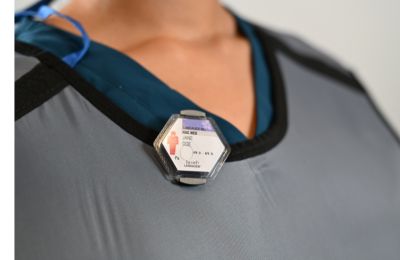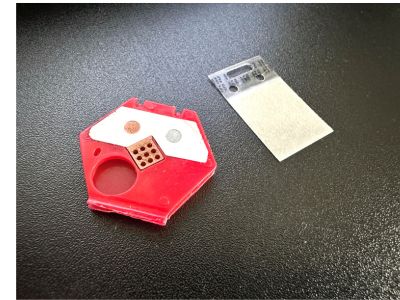
Understanding the Purpose of Radiation Badges & Personal Dosimetry
Radiation is a potential hazard in many occupations, especially in the healthcare, nondestructive testing, and research industries. High exposure to radiation can cause serious health problems, including cancer and radiation sickness. Therefore, it is important to monitor workers who are frequently exposed to radiation. While the health and safety of workers comes first and foremost, monitoring radiation exposure for regulatory compliance is also vital. Whether working in a vet clinic, a hospital setting, or a nuclear power plant, different industries have different rules they must follow.
This is where radiation badges come in. Radiation badge requirements vary according to industry, but the purpose of a radiation badge is to track each individual’s radiation exposure to ensure workers are not exceeding safe exposure levels.
In this article, we will explore more about what radiation badges are, how they work, why they are important, and the different types of radiation badges available.
What is a Dosimeter Badge?
 A radiation badge, also known as a dosimeter or an X-ray badge, is a device that measures the amount of ionizing radiation to which an individual has been exposed. These badges are worn by people who work in areas where they are likely to be exposed to radiation, such as medical imaging facilities, veterinary and dental clinics, fluoroscopy and oncology departments, nuclear power plants, research facilities, and nondestructive testing or construction sites.
A radiation badge, also known as a dosimeter or an X-ray badge, is a device that measures the amount of ionizing radiation to which an individual has been exposed. These badges are worn by people who work in areas where they are likely to be exposed to radiation, such as medical imaging facilities, veterinary and dental clinics, fluoroscopy and oncology departments, nuclear power plants, research facilities, and nondestructive testing or construction sites.
Radiation badges consist of two main components: a dosimeter and a badge holder. The dosimeter is a small device that measures the amount of radiation that the wearer is exposed to, while the badge holder is worn on the body and contains the dosimeter. Sometimes the badge is encased in a clear pouch or casing with a clip for attaching to clothing or PPE.
How Does a Radiation Monitoring Badge Work?
 The interior components of the dosimeter are made of materials that are sensitive to ionizing radiation. When the dosimeter is exposed, the material reacts to the radiation. If the badge is being worn at the time, the dosimeter is then able to measure the amount of radiation the wearer received.
The interior components of the dosimeter are made of materials that are sensitive to ionizing radiation. When the dosimeter is exposed, the material reacts to the radiation. If the badge is being worn at the time, the dosimeter is then able to measure the amount of radiation the wearer received.
Certain radiation monitoring badges may need to be docked to work correctly. In the case of an electronic digital dosimeter, it may require a physical operational dosimeter reader station to read and reset it. Some digital badges connect wirelessly to a hub for reading, and others such as the LANDAUER Luxel+ are read manually at an approved laboratory.
Radiation badges are typically worn daily depending on the radiation protection program and the job duties assigned. Dosimeters are most commonly read monthly or quarterly.
To measure the radiation dose of a TLD or OSL dosimeter, it is processed in a laboratory. The process causes the dosimeter to emit light, which is measured. The amount of light emitted is proportional to the amount of radiation to which the dosimeter was exposed.
The badge holder is designed to protect the dosimeter from physical damage and to hold it in a position so that it accurately reflects the wearer's exposure. It is also part of the calculations used, so if the holder is compromised, this may affect the accuracy or functioning of the dosimeter inside.
Why are Radiation Badges Required?
Radiation badges are important because they allow employers to monitor the exposure levels of workers who are frequently exposed to radiation. In many fields, badges are required for employees who work with ionizing radiation from devices like X-ray machines, moisture density gauges, and LINAC machines.
This information helps to ensure that workers are not exposed to levels of radiation that are higher than the acceptable levels set forth by the NRC (Nuclear Regulatory Commission) or your state. It also helps to identify areas where exposure levels are higher than expected, which can lead to improvements in ALARA (as low as reasonably achievable) and safety procedures.
Want to learn more about radiation safety and dosimetry? Watch this webinar to dig a little deeper into the why’s and how’s of radiation monitoring. Click to open in another window.
Different Types of Radiation Badges
There are several different types of radiation badges, including:
- Thermoluminescent dosimeters (TLDs): These badges use materials that emit light when the dosimeter is heated. The amount of light emitted is proportional to the amount of radiation to which the badge was exposed. TLDs cannot be re-read after they have been heated to release the stored energy, so we do not recommend their use as a whole-body monitor. TLD badges are also very sensitive to heat, so exposure to high temperatures such as being left in a hot car will render them useless. LANDAUER TLD dosimeters include the SATURN® Ring and VISION™ Lens of Eye.
- Optically stimulated luminescence dosimeters (OSLs): These dosimeters use materials that emit light when stimulated by a laser. The amount of light emitted is proportional to the amount of radiation to which the badge was exposed. OSL badges can be re-read multiple times, which is useful in situations where the dose is called into question. OSL dosimeters are able to withstand very high and low temperature extremes without affecting their use. LANDAUER OSL dosimeters include Luxel®+ and InLight®.
- Electronic digital dosimeters: These are the most advanced type of radiation badge. They use electronic components to measure the amount of radiation to which the wearer has been exposed. Some digital dosimeters like the RaySafe™ i3 can be used for realtime monitoring to immediately reduce exposure. Others are able to transmit data wirelessly, eliminating the need for regular badge exchanges. Some have alarms on them to warn the wearer of high levels of radiation. A word of caution: not all of them can be used as the legal dose of record, so be sure to verify with the provider!
- Film badges: These are the oldest type of radiation badge and not used by most organizations due to their fragility and the fact that the exposure dose fades over time, making their long-term accuracy unreliable. They consist of a small piece of photographic film inside a light-tight holder. When exposed to radiation, the film darkens. The degree of darkening is proportional to the amount of radiation to which the badge was exposed.
What is Personal Dosimetry?
While dosimetry is defined as the scientific method and measurement of ionizing radiation, personal dosimetry is the practice of tracking and measuring radiation exposure amongst individuals using radiation badges. While every person gets their own dosimeter, they do not have to individually analyze their personal dosimeter data. Periodic staff monitoring programs that companies like LANDAUER offer provide dosimeters for a set agreed upon time (anywhere from weekly to monthly to quarterly or yearly). Once that time period is up, the next batch of dosimeters are sent over, and the old ones are returned for analysis.
What is the Purpose of Personal Dosimetry?
The purpose of personal dosimetry is to track each individual’s radiation exposure. Personal dosimetry ensures that the dose for everyone who is occupationally exposed to radiation is measured and tracked. Personal dosimetry is not only important for regulatory compliance but also legally for workers to know exactly how much exposure they receive on the job. It is also crucial for companies to track their employees’ exposure levels and to take action if they are at risk of exceeding their state or NRC levels of exposure.
Legal Dose of Record
The legal dose of record is the official documentation of occupational radiation exposure for each individual. Radiation badges are required for radiation tracking. While the prescribed safety limits for occupational exposure can vary state-by-state, the Nuclear Regulatory Commission (NRC) requires no worker receives more than 5,000 millirem (mrem) per year. Dosimeters vary in the minimum level of mrem they can measure. The LANDAUER Luxel+ can detect radiation as low as 1 mrem, while the SATURN ring can detect as low as 10 mrem. That’s why it’s important to use a more sensitive dosimeter if the typical exposure levels are low.
If you are required to use radiation badges to provide a legal dose of record for your employees, you will receive regular reports from your dosimetry vendor. Be sure to clarify that the radiation badges you’re purchasing are approved for use as a legal dose of record and the vendor is an NVLAP accredited laboratory. LANDAUER users automatically get access to standard dosimetry reports, which are accessed and stored in myLDR. They include all necessary information for legal dose of record. Additional reports are available for compliance purposes.
Summarizing Personal Dosimetry
Radiation badges are an important tool for monitoring the exposure levels of workers who are frequently exposed to radiation. A dosimeter badge is the technology required for an individual to monitor their personal dosimetry. These devices are a go-to technology for people working in industries with radiation exposure, including many within the healthcare and nuclear industries. They allow employers to ensure that workers do not receive doses that are higher than the legal limits. The dosimeters are designed for ease of use so workers can get their jobs done while seamlessly ensuring their safety.
There are different types of radiation badges available depending on various factors including what businesses are looking to measure and from where. One company may need something small such as a ring, while others opt for the more common OSL badge worn on their chest. By understanding the different types of radiation badges available, organizations can choose the best option for their needs.
Personal radiation monitoring programs are key to ensuring all employees with the potential for radiation exposure have dosimeters. LANDAUER is a specialist in dosimeters and radiation protection programs. With decades of experience, our team is well-versed in all regulations necessary to protect those with occupational radiation exposure and the best dosimeters to do this work. Speak to our team about what radiation badges would be best for you and your employees.

